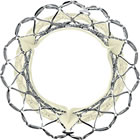|
Three-Year Results of Medtronic's Evolut TAVR Compared to Surgery in Low Risk Patients
Presented at ACC
Excellent Performance and Durability of TAVR Continues to be Seen
|
 |

Medtronic's CoreValve/Evolut™ Transcatheter Aortic Valve |
March 5, 2023 -- Since the first FDA approval a dozen years ago of a transcatheter aortic valve replacement (TAVR) for patients at extreme risk for open surgery (SAVR), clinical trials have been comparing these two therapeutic options. Incrementally the FDA has widened its approval ultimately to those patient populations at low risk for surgery. But for TAVR to compete with surgery, long term data is critical: how well do these transcatheter devices perform?; how durable are the results?; how durable are the devices themselves and do they degrade? These are questions that physicians needs answers for, in order to discuss options with patients facing these procedures.
Three-Year Results Presented at ACC
The three-year comparative data for Medtronic's CoreValve/Evolut TAVR vs. SAVR for low risk patients that were presented at today's late-breaking clinical trials session at the annual American College of Cardiology meeting in New Orleans were much needed. And the results showed that this device compared favorably with surgery and, in some respects, was superior.

Dr. John Forrest |
Dr. John Forrest, who heads the Structural Heart Disease Program at Yale Medicine, presented the three-year results from the Evolut Low Risk trial, which randomized 1414 patients, who were at low-risk for surgery, to TAVR procedures with a self-expanding, supra-annular valve (730) or surgery (684). The primary endpoint was all-cause mortality or disabling stroke. Several secondary endpoints were also included.
The mean age of patients was 74 and a third were women.
The primary endpoint, while numerically lower in the TAVR cohort, just missed statistical significance, occurring in 7.4% of TAVR patients and 10.4% of surgery patients (HR, 0.70; 95% CI, 0.49–1.00; p=0.051) although this difference remained consistent over time: -1.8% at year 1; -2.0% at year 2; -2.9% at year 3. The surgical group had significantly lower incidence of mild paravalvular regurgitation (20.3% TAVR vs. 2.5% surgery) and pacemaker placement (23.2% TAVR vs. 9.1% surgery; p<0.001) although rates of moderate or greater paravalvular regurgitation for both groups were <1% and not significantly different. Interestingly the TAVR patients had improved valve hemodynamics (mean gradient 9.1mmHg TAVR vs. 12.1mmHg surgery; p<0.001) at three years.
These results mean that this non-surgical alternative to aortic valve replacement (TAVR) may be at a point of equipoise to surgery, at least so far. There are a number of questions remaining, some of which are discussed below. But the take-away from today's study is that TAVR is now a therapy that can be discussed with greater confidence in shared decision-making with a wider group of patients.
Changes in Devices and Techniques Impact Results
One of the difficulties in assessing the results of long-term trials is that both the devices and accompanying techniques change over the course of the study. For example, since the start of the Evolut Low Risk trial, the device has changed: a "skirt" was added to reduce the incidence of paravalvular leak. And the implantation technique has changed: the cusp overlap technique started being used, significantly reducing the need for pacemaker placement down to single digits, making it comparable to surgery. These results were just presented at last year's EuroPCR meeting, so the results of today's presentation may be modified in the future in favor of TAVR. (For more information on the cusp overlap technique, watch this video discussion with Drs. Douglas Fraser, Darren Mylotte and Steven Yakubov.)
However, the big thing to watch in all these valves is durability, because that may be limiting in younger patients. Do these valve leaflets degrade over time? If the "shelf-life" of a valve is only 5-10 years, do you want to implant it in a 70-year-old? This is why long-term studies are so important (the Evolut Low Risk trial will be studying these patients out to 10 years). Of note, the Evolut TAVR platform has shown superior durability to surgically-placed bioprosthetic valves at five years.
Twenty Years of TAVR
It was twenty years ago that the first TAVR (or TAVI) was implanted in a human by Dr. Alain Criber in France. Today Dr. John Forrest said in his presentation that, "The consistent benefit of TAVR at three years is not something that has been observed in prior studies and provides further evidence that TAVR deserves to be the dominant treatment modality for patients with aortic stenosis undergoing valve replacement." And this opinion is shared by many in the cardiology field, especially looking to the future of interventional therapies for other valves. As Dr. Gervasio Lamas tweeted this morning, quoting Bob Dylan, "With regards to TAVR versus SAVR, 'you don't need a weatherman to know which way the wind blows'.... I say we focus on the mitral valve and the tricuspid valve."
This morning's press release from Medtronic follows:

Medtronic Evolut™ TAVR platform Shows Excellent Valve Performance and Durability in Low-Risk Aortic Stenosis Patients
ACC.23/WCC Late-Breaking Clinical Trial: Evolut™ is Only TAVR to Show Excellent Outcomes in Low-Risk Patients at 3 Years
March 5, 2023 -- Medtronic today announced three-year data from the Evolut Low Risk Trial, demonstrating the Medtronic EvolutTM transcatheter aortic valve replacement (TAVR) System had numerically better clinical outcomes and significantly better hemodynamic valve performance than surgical aortic valve replacement (SAVR) in low-risk aortic stenosis (AS) patients. The data was presented as late-breaking clinical data at the American College of Cardiology’s 72nd Annual Scientific Session Together with World Heart Federation’s World Congress of Cardiology and simultaneously published in the Journal of the American College of Cardiology.
“With an increasing number of younger, low risk patients undergoing TAVR, there is a critical need to better understand the intermediate and longer-term durability of TAVR to aid in the shared decision making between patients and providers,” said Dr. John Forrest, MD, FACC, FSCAI, Associate Professor of Medicine, Director of Interventional Cardiology, Cardiovascular Medicine; Director of Structural Heart Disease, Yale Medicine; Director, Structural Heart Disease Program, Cardiovascular Medicine. “These positive mid-term results from the Evolut Low Risk Trial add to the growing body of clinical evidence demonstrating the benefits of Evolut TAVR for a broad set of patients.”
The Evolut™ Low Risk Trial was a prospective, randomized, multicenter, noninferiority study to assess the safety and efficacy of the Evolut™ TAVR system compared to SAVR in patients with a low predictive risk of 30-day surgical mortality. Low risk patients, defined in the trial as a predicted risk of 30-day mortality <3% per multidisciplinary local heart team assessment, were randomized to TAVR with a self-expanding, supra-annular CoreValve, Evolut R, or PRO bioprosthesis or SAVR. A total of 1414 patients underwent attempted implant (730 TAVR; 684 SAVR). Patients had a baseline mean age of 74 years and STS score of 2.0 and 1.9 in the TAVR and SAVR groups, respectively.
In the trial, Evolut™ TAVR demonstrated a numerical benefit compared to surgery in the primary end point of all-cause mortality or disabling stroke at three years (7.4% Evolut TAVR, 10.4% SAVR; p=0.051). Evolut™ TAVR patients had less moderate or greater prosthesis-patient mismatch (PPM) at 3 years compared to SAVR (10.6% Evolut™ TAVR, 25.1% SAVR; p<0.001), which occurs when the valve is too small for the patient's body size. These findings support the two-year data published in JACC1 demonstrating the improved hemodynamic valve performance of supra-annular, self-expanding TAVR compared with surgery.

Nina Goodheart |
“As Medtronic works to expand the benefits of TAVR to a broader patient population and empower physicians to deliver individualized lifetime care, the results of the Evolut Low Risk Trial are an important milestone for our TAVR platform,” said Nina Goodheart, senior vice president and president of the Structural Heart & Aortic business within the Cardiovascular portfolio at Medtronic. “These data add to the robust body of evidence demonstrating that the Evolut platform offers excellent valve performance and remains hemodynamically stable for years to come in younger, healthier patients.”
The Medtronic CoreValve™ and next generation Evolut™ systems are TAVR devices used in a procedure that is less invasive than traditional open-heart surgery for patients with symptomatic severe aortic stenosis.
Any forward-looking statements are subject to risks and uncertainties such as those described in Medtronic's periodic reports on file with the Securities and Exchange Commission. Actual results may differ materially from anticipated results.
About Medtronic
Bold thinking. Bolder actions. We are Medtronic. Medtronic plc, headquartered in Dublin, Ireland, is the leading global healthcare technology company that boldly attacks the most challenging health problems facing humanity by searching out and finding solutions. Our Mission — to alleviate pain, restore health, and extend life — unites a global team of 90,000+ passionate people across 150 countries. Our technologies and therapies treat 70 health conditions and include cardiac devices, surgical robotics, insulin pumps, surgical tools, patient monitoring systems, and more. Powered by our diverse knowledge, insatiable curiosity, and desire to help all those who need it, we deliver innovative technologies that transform the lives of two people every second, every hour, every day. Expect more from us as we empower insight-driven care, experiences that put people first, and better outcomes for our world. In everything we do, we are engineering the extraordinary. For more information on Medtronic (NYSE:MDT), visit www.Medtronic.com and follow @Medtronic on Twitter and LinkedIn.
Reported by Burt Cohen, March 5, 2023 |



